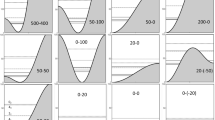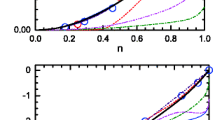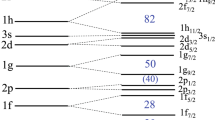Abstract
Systematic Spin Assignments were generally made by using the argument that the energy of levels is a function of neutron number. In the present systematics, the excitation energy of the levels incorporated the effect of nuclear deformation and signature splitting. The nuclear deformation changes toward the mid-shell, therefore a smooth variation in the excitation energy of the levels is observed towards the mid-shell, that intended to make systematics as a function of neutron number towards the mid-shell. Another term “signature splitting” that push the energy of levels for odd- and even-spin sequences up and down, caused the different energy variation pattern for odd- and even-spin sequences. The corrections made in the spin systematics were tested for the known spins of various isotopic chain. In addition, the inconsistency in spin assignments made by the spin systematics and other methods of the configuration π h 11/2 ⊗ νh 11/2 band belonging to 112,114,116Cs, 126Pr, and 138Pr, as an example, was resolved by the correctionmade in the present spin systematics.
Similar content being viewed by others
References
Yunzuo Liu et al., Phys. Rev. C 52, 2514 (1995).
J. R. B. Oliveira et al., Phys. Rev. C 39, 2250 (1989).
J. F. Smith et al., Phys. Rev. C 63, 024319 (2001).
P. T. Wady et al., Phys. Rev. C 85, 034329 (2012).
Yunzuo Liu et al., Phys. Rev. C 54, 719 (1996).
T. Koike et al., Phys. Rev. C 67, 044319 (2003).
J. F. Smith et al., Phys. Rev. C 74, 034310 (2006).
M. L. Li et al., Phys. Rev. C 75, 034304 (2007).
D. J. Hartley et al., Phys. Rev. C 65, 044329 (2002).
F. S. Stephens, Rev.Mod. Phys. 47, 43 (1975).
R. Bengtsson et al., Nucl. Phys. A 389, 158 (1982).
R. Bengtsson et al., Nucl. Phys. A 415, 189 (1984).
I. Hamamoto, Phys. Lett. B 235, 221 (1990).
P. Semmes and I. Ragnarsson, Report Presented at International Conference on High Spin Physics and Gamma-Soft Nuclei, Pittsburgh, PA, 1990.
K. Hara and Y. Sun, Nucl. Phys. A 531, 221 (1991).
A. K. Jain and A. Goel, Phys. Lett. B 277, 233 (1992).
K. Hara, Nucl. Phys. A 557, 449 (1993).
N. Yoshida, H. Sagawa, and T. Otsuka, Nucl. Phys. A 567, 17 (1994).
M. Matsuzaki, Phys. Lett. B 269, 23 (1991).
G. Gangopadhyay et al., Eur. Phys. J. A 24, 173 (2005).
C. M. Petrache et al., Phys. Rev.C 64, 044303 (2001).
K. S. Krane, R. M. Steffen, and R. M. Wheeler, At. Data Nucl. Data Tables 11, 351 (1973).
K. Starosta et al., Phys. Rev. C 62, 044309 (2000).
C.-B. Moon et al., Nucl. Phys. A 730, 3 (2004).
E. S. Paul et al., J. Phys. G 22, 653 (1996).
R. Zheng et al., Phys. Rev. C 64, 014313 (2001).
C. M. Petrache et al., Nucl. Phys. A 597, 106 (1996).
C. M. Petrache et al., Nucl. Phys. A 603, 50 (1996).
J. F. Smith et al., Phys. Lett. B 406, 7 (1997).
C.-B. Moon et al., Nucl. Phys. A 696, 45 (2001).
F. R. Xu, W. Satula, and R. Wyss, Nucl. Phys. A 669, 119 (2000).
J.-Y. Zhang and P. Semmes, private communication.
M. G. Procter et al., Phys. Rev. C 87, 014308 (2013).
http://radware.phy.ornl.gov
M. Sandzelius et al., Phys. Rev. Lett. 99, 022501 (2007).
Jingbin Lu et al., Phys. Rev. C 62, 057304 (2000).
B. Cederwall et al., Nucl. Phys. A 542, 454 (1992).
J. F. Smith et al., Phys. Rev. C 58, 3237 (1998).
J. F. Smith et al., Phys. Rev. C 73, 061303 (2006).
T. Komatsubara et al., Nucl. Phys. A 557, 419c (1993).
Author information
Authors and Affiliations
Corresponding author
Additional information
The text was submitted by the author in English.
Rights and permissions
About this article
Cite this article
Kumar, V. A test for correction made to spin systematics for coupled band in doubly-odd nuclei. Phys. Atom. Nuclei 78, 1001–1007 (2015). https://doi.org/10.1134/S1063778815080074
Received:
Accepted:
Published:
Issue Date:
DOI: https://doi.org/10.1134/S1063778815080074




